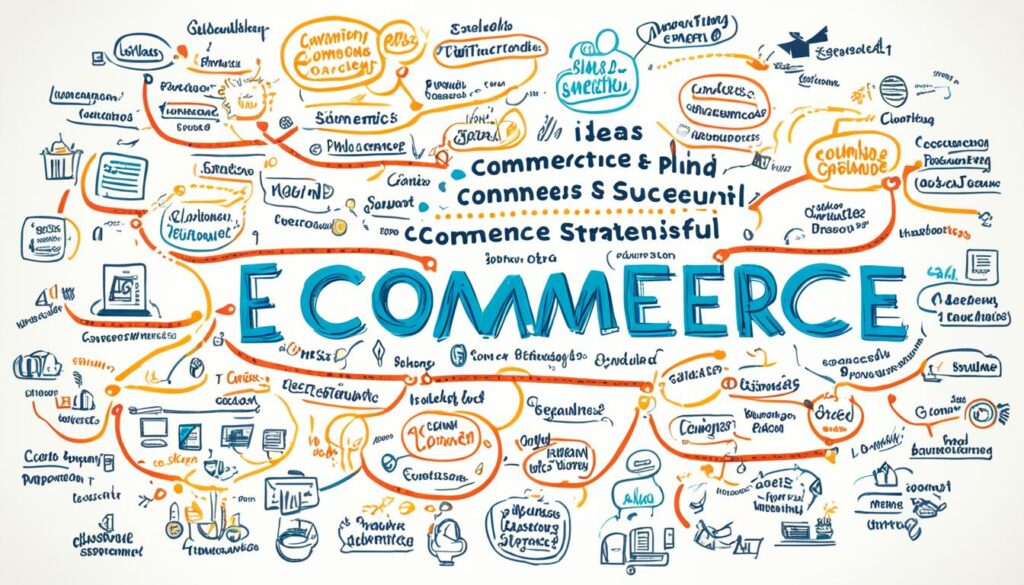Starting an e-commerce business is exciting. But, you need a strong foundation for success. This guide will show you how to set up and enhance your online store. It will also cover digital marketing strategies, choosing the best e-commerce platform, and using analytics tools.
Whether you’re new to the online world or want to grow your current business, this guide is for you. It has all you need to stand out in the competitive online market.
Key Takeaways:
- Learn the essential steps to launch and grow a successful e-commerce business.
- Discover effective strategies for setting up and optimizing your online store.
- Explore digital marketing techniques to drive traffic and increase conversions.
- Compare different e-commerce platforms to find the right one for your business.
- Utilize e-commerce analytics tools to analyze and improve your business performance.

Now, let’s start the first part of our guide. It will help you begin your e-commerce success journey.
Find Product Opportunities and Choose What to Sell.
Starting an e-commerce business means finding the right products. This step is vital for your success online.
Doing detailed research on products is crucial. It helps find profitable niches and trends. By knowing what people want, you can pick products that sell well.
It’s also key to check if your product ideas will work. Passion matters, but you need to know if people will buy what you’re selling. This ensures your chosen items have a market and can stand out.
Deciding how to get your products is another big decision. You could use dropshipping, buy from makers or suppliers, or try print-on-demand. Think about costs, quality, and how to deliver when choosing.
Picking products should be about what your customers want. Know their likes, needs, and shopping habits. This makes it more likely your products will sell well and please your buyers.
Product Research Process
- Identify profitable niches
- Research market trends
- Validate product ideas
- Consider sourcing options
- Align products with target market
Examples of Product Opportunities
| Product Category | Market Demand | Trending Factors |
|---|---|---|
| Health and Wellness | High | Rising interest in self-care |
| Home Office Essentials | Increasing | Remote work trend |
| Sustainable Products | Growing | Environmentally conscious consumer base |
Quote
“The key to success in e-commerce is finding the right products that meet market demand and align with your target audience.” – Successful E-commerce Entrepreneur
Exploring different product opportunities and doing deep research are key. Ensure your products match your target market. Then, research your competition and create a detailed business plan. This will set you on the path to success.
Thoroughly Research Your Competition and Write a Business Plan.
Starting and growing a successful e-commerce business begins with two key steps. First, thoroughly research your competition. Then, write a comprehensive business plan. This approach lets you grasp your competitors’ strategies, strengths, and weaknesses. You’ll recognize areas where you can stand out.
Begin with a competitive analysis to see how others are faring in the market. Look at their products, pricing, marketing, and how they engage customers. This analysis will clue you into the competitive scene. It lets you spot unique opportunities.
It’s also smart to run a SWOT analysis on your own business. This will show your strengths, weaknesses, opportunities, and threats. Understanding these elements helps you build strategies. You’ll know how to use your advantages, fix weaknesses, seize chances, and avoid risks.
After rigorous research and analysis, it’s time to write your business plan. This plan is your e-commerce roadmap. It outlines goals, target markets, marketing strategies, finances, and your mission. It guides decisions and attracts investors. It shows you’re committed and understand the market.
To build an effective business plan, include certain parts:
- Executive Summary: Offer a snapshot of your business, spotlighting key plan points.
- Company Description: Share your business’s mission, core values, and objectives.
- Market Analysis: Dive deep into your target market. Cover customer demographics, trends, and competitor analysis.
- Product or Service Offering: Describe what you’re selling and why it’s needed.
- Marketing and Sales Strategies: Lay out how you’ll reach customers and sell to them. Include your budget.
- Operational Plan: Discuss your business operations, supply chain, and customer service.
- Financial Projections: Show your financial future. This includes earnings, spending, and money flow forecasts.
- Implementation Plan: Spell out launch and growth steps, with timelines and goals.
- Mission Statement: Define your business’s purpose and core values.
Remember, your business plan is not set in stone. It should grow as your e-commerce business expands. Keep it updated to reflect your current goals and the market’s changes.

| Competitor | Strengths | Weaknesses | Opportunities | Threats |
|---|---|---|---|---|
| Competitor 1 | Strong brand recognition | Limited product range | Expanding market segment | New competitors entering the market |
| Competitor 2 | Wide product selection | Poor customer service | Untapped international markets | Rapidly changing consumer preferences |
| Competitor 3 | Efficient supply chain | High prices | Increase online presence | Economic downturn |
Choose a Logo and Name and Set Up Your Online Store.
Starting an online store means you need a strong brand identity. Choosing a memorable logo and a resonant name is key. This step is your first move in establishing a strong brand.
Think about your brand’s values, your target market, and what you sell. What emotions do you want your logo to show? How does the name reflect your brand? You can design your logo online with tools like Canva or hire a designer.
With a logo and name ready, setting up your online store is next. Picking the right e-commerce platform is important. It should allow easy setup, customization, and SEO to make your store shine and rank high.
Choose a website design that matches your brand. Focus on color, typography, and layout for a good user experience. Make sure your product pages are easy to navigate.
Using SEO best practices helps people find you online. Optimize your site and product descriptions with sensible keywords. Creating blogs and earning backlinks can boost your site’s rank.
Your logo, name, and store setup are crucial first impressions. Invest in a strong brand identity and a well-optimized website. This foundation sets your online store up for success.
Example Logo and Name
Here’s how an e-commerce brand named GreenLife Essentials matches their logo to their values:
| Logo | Name |
|---|---|
 |
GreenLife Essentials |
GreenLife Essentials focuses on eco-friendly products. Their logo, a green leaf with sleek text, highlights their environmental ethos. It shows they care about the planet and appeals to eco-conscious consumers.
Choose Your Shipping Strategy and Set Sales and Marketing Goals.
Picking the right shipping strategy is key for a booming e-commerce business. It needs to match your products, audience, and budget. This way, you can ship orders well and keep your customers happy.
Setting clear sales and marketing goals is also vital. Sales goals let you monitor progress and aim for specific earnings. With set sales goals, you’re ready to boost revenue and improve your business.
Marketing goals help in spreading the word about your products, pulling in customers, and making your brand known. Your marketing plan should speak to your audience and highlight what’s unique about your products. By using online stores, marketplaces, and social media, you can reach many people.
Choosing the Right Sales Channels
Choosing sales channels that match your audience is crucial. While your online store is your base, marketplaces like Amazon or eBay can broaden your visibility. Social media platforms like Facebook and Instagram help you connect directly with customers.
Mixing social media marketing into your strategy builds brand loyalty and draws folks to your online store. Social media lets you talk with your audience, announce product news, and create a community around your brand.
Table:
| Sales Channel | Benefits |
|---|---|
| Your Online Store | Complete control over your brand, customer experience, and data. |
| Marketplaces (e.g., Amazon, eBay) | Access to a large customer base and built-in trust and credibility. |
| Social Media (e.g., Facebook, Instagram) | Direct customer engagement, brand building, and promotional opportunities. |
Using different sales channels can spread your reach and boost your e-commerce success.
Success grows when you fine-tune your shipping strategy, set clear goals, and pick the right sales channels. Use social media marketing and varied channels to reach more people and grow your sales.

Launch Your Business.
Congratulations! You’re ready to start your e-commerce business. It’s an exciting journey ahead. To kick off successfully, you’ll need smart marketing moves. Let’s look at the important steps to take:
Develop a Marketing Plan
Having a solid marketing plan is key. It drives people to your online store and boosts sales. First, know who your customers are and what they like. This helps you tailor your marketing just right.
Use a mix of strategies in your plan, like email marketing, social media advertising, and content marketing. Email marketing connects you with future customers. Social media opens up your customer base. Content marketing, like blogs or videos, makes you an industry go-to and brings in visitors.
Implement Customer Acquisition Strategies
Getting and keeping customers is what keeps a business going. Come up with ways to create a dedicated customer group. One way is to offer specials for first-time buys, like discounts or free shipping.
Also, use happy customer feedback as a tool. Ask them to leave reviews. Good feedback boosts trust in your brand for new customers.
Monitor and Analyze
Keep an eye on how your marketing does and refine it for better results. Use analytics to see what’s working. Look at website visitors, how many buy, and how engaged they are. This info helps improve your marketing strategies.
Launching a business is just the start. Always update your marketing to keep up with what customers want.

| Marketing Tactics | Benefits |
|---|---|
| Email Marketing | Directly reach customers and nurture leads |
| Social Media Advertising | Expand reach and build brand awareness |
| Content Marketing | Establish industry expertise and attract organic traffic |
E-commerce Benefits, Trends, and Types of E-commerce.
E-commerce is changing how businesses work, giving many benefits to both buyers and sellers. Knowing these benefits, keeping up with new trends, and understanding the different e-commerce types are key. They help you make smart choices and do well in the online market.
E-commerce Benefits
- Convenience: One big plus of e-commerce is how easy it makes shopping for consumers. People can shop online anytime from home, skipping trips to the store. This saves time.
- Cost Savings: E-commerce means businesses can spend less on running their shop compared to regular stores. They save on rent and other costs, which means they can make more profit or offer better prices.
- Wider Reach: Normal stores often can only sell to people nearby. But e-commerce opens up the whole world, letting businesses reach more people everywhere. This means more customers and chances to grow.
- Targeted Communication: With e-commerce, businesses can really get to know their customers. They can send marketing that really speaks to each person, leading to more sales.
E-commerce Trends
“The growth of e-commerce sales in the US and globally shows how popular and impactful it has become in retail.”
Staying current with e-commerce trends helps you compete and meet what customers want. Here are some important trends:
- Mobile Commerce: With more people using smartphones, shopping on mobile is growing fast. Businesses must make sure their online stores work well on mobile devices.
- Social Commerce: Social media is now also a place to sell products directly to followers. Using social commerce wisely can increase sales and make the most of social media’s influence.
- Personalization: Customers like shopping experiences made just for them. Businesses that offer personalized services, products, and deals stand out from the competition.
- Augmented Reality (AR) and Virtual Reality (VR): AR and VR can make online shopping more real and engaging. They help customers get a better sense of products before buying.
Types of E-commerce
There are different models of e-commerce, each serving specific needs and strategies:
| Type | Description | Examples |
|---|---|---|
| B2B (Business-to-Business) | This is when businesses sell goods or services to other businesses. | Alibaba, Cisco |
| B2C (Business-to-Consumer) | Here, businesses sell directly to individual shoppers. | Amazon, Walmart |
| C2C (Consumer-to-Consumer) | This is when individuals sell or trade items with each other. | eBay, Craigslist |
Knowing the different e-commerce types helps you plan better depending on who you’re selling to and your business goals.

In summary, e-commerce brings many advantages, follows changing trends, and includes various transaction types. By using e-commerce, businesses can enter a worldwide market, offer easy shopping, and connect deeply with customers online.
Sales Tax Considerations for Your Online Store.
When you run an online store, it’s essential to think about sales tax. Each state in the U.S. has its own rates and rules for sales tax. It’s key to know and follow these to avoid trouble.
Getting to know the sales tax rates for different states is crucial. This understanding helps you collect the right amount of tax from your customers. It’s all about staying compliant with each state’s laws where you do business.
Talking to a tax professional is a smart move to figure out your sales tax duties. They can help you understand the complex world of sales tax. This way, you can correctly collect and send sales tax to the government.
Keeping up with sales tax laws and getting advice from experts helps keep your online store lawful. Being well-informed and proactive about your sales tax tasks is vital for your business’s success.

Key Takeaways:
- Each state in the United States has its own sales tax rates and regulations.
- Understanding the sales tax rates for different states is crucial for compliance.
- Consulting with a tax professional is recommended to determine your specific sales tax obligations.
- Implement the necessary processes for collecting and remitting sales tax to stay compliant with the law.
Choosing the Right E-commerce Software.
Picking the right e-commerce software is key to opening and running a successful online store. A good platform offers you the tools to build an attractive and easy-to-use online store. Here’s what to keep in mind when choosing an e-commerce platform:
- Customization Options: Choose a platform that lets you change your website’s look to match your brand. It should help you make a store that is both beautiful and consistent.
- Ease of Use: The software should be simple and straightforward. This makes running your store and handling orders much easier.
- Payment Options: Make sure the platform supports many secure payment methods. This makes buying things easier and safer for your customers.
- Language Abilities: If you’re selling to international customers or those who speak different languages, pick software that supports many languages. It helps you reach more people around the world.
- Support: The level of customer support is important. Choose platforms that offer good help so you can solve problems quickly.
Certain e-commerce software stand out, each with unique features and benefits. Some top choices include:
| E-commerce Software | Key Features |
|---|---|
| Shopify | Great customization, user-friendly, lots of apps |
| Squarespace | Beautiful designs, blogging option, SEO tools |
| WooCommerce | Works well with WordPress, flexible, community support |
| Magento | Highly advanced, scalable, very flexible |
Each platform suits different business needs. Think about what your business requires to choose the best software for your store.
Choosing the ideal e-commerce software is crucial. It helps you create a store that looks great, is easy to use, and serves your customers well. This, in turn, boosts your sales.

Best Practices for E-commerce Marketing and Website Optimization.
Successful e-commerce depends on effective marketing and site optimization. Implementing top strategies in e-commerce marketing boosts product promotion. This drives traffic to your online store.
Using social media ads is a strong strategy. Sites like Facebook and Instagram target specific groups, making sure your ads find the right eyes. Email campaigns also help in keeping customers coming back.
Offering personalized deals can increase sales. Analyzing customer history allows for offers that really speak to them. This not only makes customers happy but also brings them back.
Gathering customer feedback is vital. It helps understand what customers like and what they don’t. Using this info lets you improve your offerings and how you sell them.
Improving your website is as important as marketing. A user-friendly, fast, and mobile-responsive site is key. Adding personalized recommendations can make shopping more enjoyable. Keep tracking and analyzing your site and marketing to grow your business.